5 Examples Why You Should Be a Skeptical Gluten Free Consumer
January 6, 2015 by Amy Leger | G+ Amy LegerI had the craziest moment the other day, one which is prompting me to write this post showing five examples of why a healthy skepticism for the gluten free consumer is probably a good thing. I am specifically talking about in the grocery store, liquor store and at restaurants.
A few days ago, I called a new restaurant that has a gluten-free option for pizza. Emma was going to her friend’s 16th birthday party and her mom wanted to buy Emma a gluten-free pizza, but she wasn’t sure what would be okay.
Well, in my suburban neighborhood, between Domino’s, Papa Murphy’s and a few local chains, every single one of them shares ingredients between the gluten filled and the gluten free pizzas– including the sauce. So with a new pizza place in town I thought I would check again.
I called and talked to a manager at The 641, a new pizza joint in Blaine, MN. I asked if they had gluten-free pizza. He explained to me that their gluten free crust was prepackaged and only came out when they received an order. He talked about having separate utensils and tools for managing the prep of the pizza. Then I asked about the ingredients, were they shared? Well yes they were. And then he said,
“The pizza is gluten-FREE, but not gluten-LESS” — The 641 on gluten free pizza
What? Did he hear what he just said? I responded by telling him both gluten free and gluten less really mean the same thing. And that maybe he’s really making just a low gluten pizza which doesn’t work for people who have to be gluten free. And I thanked him for his time and hung up.
I know I am in the business of educating people about gluten free but sometimes I get tired….sorry.
Here are my other examples (most of which are from my suburban hometown, but I am sure silly things like this are happening everywhere):
2. Years ago, another restaurant (also in Blaine) wrote on their menu they had “glutton free pizza crust”. The menus were reprinted not long after this photo was taken.
3. Last February, I did an article on labeling of gluten-free versus gluten-removed beer. I ran to my liquor store to take a look at Omission’s packaging of its gluten-removed beer product. I noticed at the time, the shop had in-store marketing on the rack that labeled it all gluten free. The TTB, which oversees the labeling of these kinds of beers explained to me, in-store marketing is not overseen by the TTB, so at that point it is out of their control.
4. And explain this one to me: the grocery store does a special rack highlighting Goodbye Gluten, which is a gluten-free, shelf-stable bread. Not only does the sign have the name of the product wrong, calling it Goodbye Gluten Free, but it also gave varieties of “white” or “wheat”.
5. Over the weekend, Jules Shepard of gfJules posted a photo of the gluten-free sign in a section at her WalMart and none of the products in that section was gluten free.
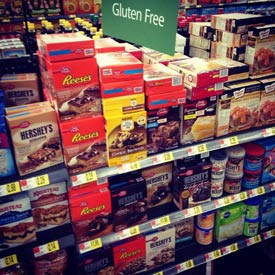
No GF products in gluten-free section at a Walmart recently visited by Jules Shepard; photo credit: Jules Shepard
Mistakes in the gluten-free arena are everywhere. You just need to be a little cautious when you shop or go out for a meal.
Getting gluten free products
Marketing and promotions in stores are posted by people who may or may not know anything about the product they are showcasing, gluten-free or not. So it is important to become your own advocate and expert in your own health.
The best and most basic ways to keep yourself as gluten free as you can in this gluten-filled world is to:
- Get educated — know what gluten is and what gluten free means, understand the cross contamination hazards, and stay on top of the changing products. Sometimes food that was once gluten free is now not and vice versa.
- Learn and maintain your ingredient reading skills — when you know what gluten is, where it can hide, you can be more confident knowing you are eating safe food. Even though we have gluten-free labeling standards for companies who want to label a product gluten-free, mistakes can also happen in manufacturing. Ingredient label reading should be able to catch those mistakes (and then you should report the inaccuracy to the FDA if you ever see gluten in a gluten-free labeled product).
- Ask pointed questions at a restaurant (or call ahead if you don’t want to ask a lot of questions in the heat of your dining experience). Examples: do you share ingredients between gluten-free and gluten-filled products (in particular for sandwich shops and pizza restaurants)? Can we bake the french fries instead of frying them in the contaminated oil? Menus labeled “gluten sensitive” or “gluten friendly” are a first red flag for me, because by avoiding the term “gluten free”, restaurant staff may feel like they can be more relaxed on potential gluten contamination. — in my opinion. This may not be the case for all, but I have seen this a lot in the last year.
- When at the liquor store and you are shopping for beer, look on the actual product label to see if it says “gluten free” or “gluten removed”. The in-store gluten-free marketing may draw you to the right location, but from there you need to look closely at the product itself. Gluten-removed beer must say gluten removed on the label, if it started with a gluten grain and used a process to reduce or remove the gluten. Actual gluten-free labeled beers only use gluten free grains. Read more on this topic here.
Best of luck being a gluten free consumer. If you have questions or other suggestions, comment below or ask on our Facebook page.
Tags: cautious, consumer, error, free, gluten, gluten-free, grocery, ingredients, label, liquor, products, restaurant, shopping, skeptic, store, tips
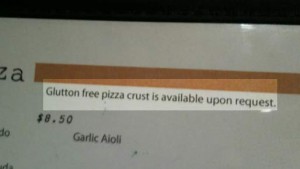
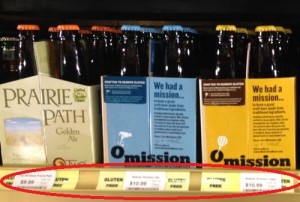
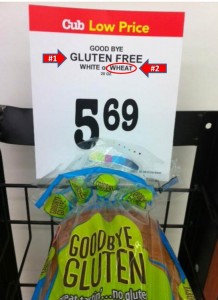


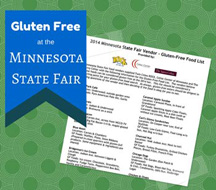
January 6th, 2015 at 10:44 am
I appreciate your articles and read them all the time. I went GF due to Celiac Disease almost four years ago now. I became a very aware shopper very quickly as I was frequently given ‘supposed’ GF foods that were clearly not and made me very ill.
I had to respond to this article because of the Walmart photo. In the past year or so my local Meijer has created and then expanded a GF section. It is wonderful!! My husband and I were in there a month or so ago and were browsing the items and found that someone had stocked non-GF stuff in a GF section with a GF tag. Well, to make sure no one was harmed we obtained a cart and pulled all of the non-GF stuff off of the shelf, put it into the cart and gave the cart to the nearest stock clerk. We explained that it was stocked incorrectly and that if they left it in the GF section they could harm their customers. It hasn’t happened since.
I have also tried to educate the food purchaser regarding which brands taste better. They seemed to be having trouble selling some stuff and I was concerned they would think that the GF was not selling when in reality it was just that there were better GF alternatives than those offered. It seems to have worked as the section is frequently expanding both in size and product offering. They also now have a GF freezer section.
Thank you for all that you do for us.
January 6th, 2015 at 11:03 am
I love when a restaurant has GF pasta and then cooks it in the hot water used for regular pasta!!!!! All the time!!!